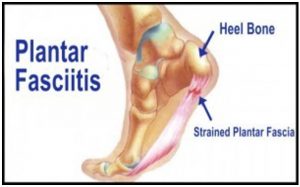Diagnosis: Plantar Fasciitis
What is Plantar Fasciitis?
Plantar Fasciitis is the most common source of heel pain in adults. Here the fibrous tissue under the foot becomes irritated and inflamed, and causes pain when running, jogging or walking1.
Plantar Fasciitis is the most common source of heel pain in adults. #performbetter @pogophysio Share on XSymptoms of Plantar Fasciitis
The following shows the common signs many people with plantar fasciitis complain of. Many experience one or more of the following symptoms1, 2, 3:
- Heel pain with the first steps in the morning or following long periods of sitting/lying
- Pain in the inside of the heel
- Limping during walking due to pain
- Pain becoming worse when on barefoot or hard surfaces, such as; concrete and tiles
- Pain in the heel when climbing stairs
- Pain in heel during jogging, jumping, running or walking
How is Plantar Fasciitis Diagnosed?
The physiotherapist is able to diagnose plantar fasciitis through your symptoms, history and examination. Usually, those with plantar fasciitis have recently taken up new activity such as long distance running and complain of a sudden onset of heel pain2. Pain is usually worst in the morning and after long periods of sitting or lying2. On examination, the physiotherapist may fell around the heel in order to see if there is any swelling or tenderness in the area. They may also look at movements of the ankle to see if it causes pain or if there is any restriction to normal movement. The physiotherapist will generally look at your walking and/or running patterns, and foot posture to see if it could contribute to the symptoms present. On some occasions you may be referred for an ultrasound or x‐ray to see if there is any damage to the bone or tissues in the area1.

http://cottesloephysio.com.au/2015/08/plantar-‐fasciitis/
What Causes Plantar Fasciitis?
The plantar fascia is a strong tissue structure located at the bottom of the foot connecting from the heel to the toes. Its role is to support the bones and arch of the foot in order to push off from the ground during walking, running or jumping. The plantar fascia also provides shock absorption when the foot is placed on the ground3. Certain sports and activities, including those with repeated running or jumping place a lot of repeated stress on the plantar fascia bruising or overstretching it causing inflammation and heel pain3. Also, those who have a high or low foot arch may also be at a greater risk of developing plantar fasciitis due to higher amounts of stretch and reduced shock absorption respectively1.
How is Plantar Fasciitis treated?
At first gentle stretching of the plantar fascia is recommended to help with the healing process. Taping is another common technique a physiotherapist may use and suggest to help decrease the stress on the fascia especially during activity, where the pain is made worse1. In the taping technique the tape is pulled under the heel and foot to help lift up and support the arch of the foot. The physiotherapist may recommend orthotics to place in the shoes to help distribute the pressure on the feet more evenly, which may help relieve the pain2. Most often the physiotherapist will help provide a series of stretches and leg exercises to help stretch out the fascia and strengthen the muscles to help provide stability to the ankle1.
Shanam Nisha
Student Physiotherapist
Resources
- http://physioworks.com.au/injuries-‐conditions-‐1/plantar-‐fasciitis
- http://sma.org.au/resources-‐advice/injury-‐fact-‐sheets/plantar-‐fasciitis/
- http://www.physio-‐com/Plantarfasciitis








